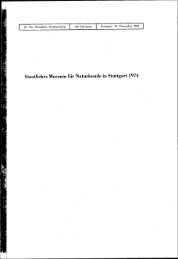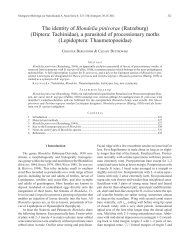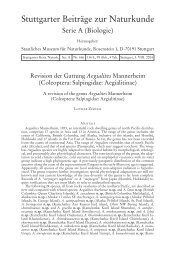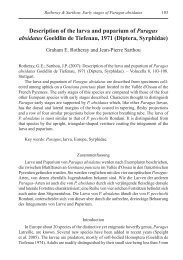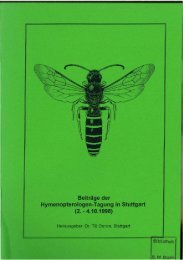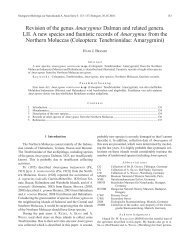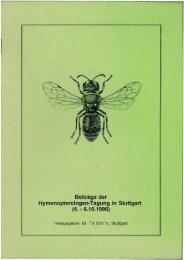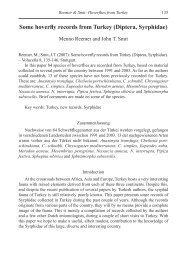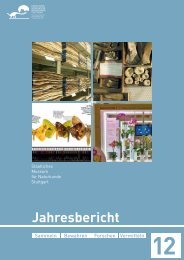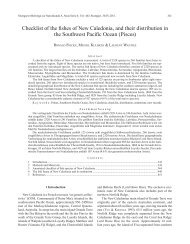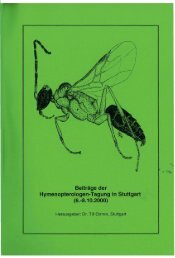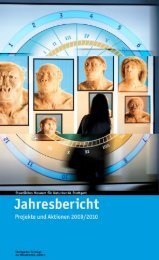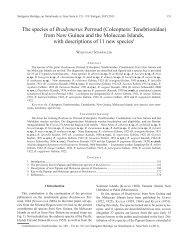Serie A (Biologie) - Staatliches Museum für Naturkunde Stuttgart
Serie A (Biologie) - Staatliches Museum für Naturkunde Stuttgart
Serie A (Biologie) - Staatliches Museum für Naturkunde Stuttgart
Create successful ePaper yourself
Turn your PDF publications into a flip-book with our unique Google optimized e-Paper software.
schawaller, oriental species of bradymerus 45Bradymerus gebieni n. sp. (Figs. 32, 98)Holotype (): W Sumatra, Bengkhulu Prov., near Curup, Bukit Kaba Mt., 1000–1500 m,30.I.–2.II.2000, leg. J. BEZDĚK, SMNS.Paratypes: Same data as holotype, 6 ex. SMNS. – Sumatra, Brastagi, leg. MJÖBERG, 3 ex.NHMB-F. – W Sumatra, Gunung Singgalang, 1800 m, VII.1925, leg. E. JACOBSON, 1 ex.MNHUB (elongatus Perty det. GEBIEN).Etymology: Named in memory of HANS GEBIEN (1874–1947), first monographer (1925)of the genus Bradymerus.Description: Dorsal view see Fig. 32, dorsal side ferrugineous without metallicshine, body length 5.5–6.8 mm. Genae slightly broader than eyes, frons with distinctsupraorbital keels. Last 6 antennomeres forming a club. Anterior corners of pronotumprotruding, lateral margin with distinct crenulation, pronotal disc with roughpunctation and with medial impression, between punctures with granules. All elytralintervals with longitudinal and confluent tubercles forming interrupted keels, alternateintervals 3, 5, 7 slightly more prominent. Tibiae in both sexes externally withdistinct keels. Aedeagus see Fig. 98.Diagnosis: To be recognized by the shape and dorsal structure of the pronotumand elytra, by only slightly dilated genae, by a 6-segmented antennal club, and bythe shape of the aedeagus. Extremely similar, also in the shape of the aedeagus, is B.aratus Fairmaire, 1896 from Borneo and Sumatra, but in this species the genae aredistinctly dilated, the pronotum is more convex and the tubercles on the elytral intervalsare much higher and not confluent. As long as no intermediate forms areknown, I consider both as different species. See also B. gerstmeieri n. sp. from Sumatra.Bradymerus gerstmeieri n. sp. (Figs. 33, 99)Holotype (): Sumatra, Prov. Jambi, Kerinci-Seblat NP, Danau Tujuh, 2000–2250 m,11.–14.VII.2001, leg. R. GERSTMEIER, CRGT.Paratypes: Same data as holotype, 1 ex. CRGT, 1 ex. SMNS.Etymology: Named in honor of Prof. Dr. ROLAND GERSTMEIER (Freising), collector ofthe type series.Description: Dorsal view see Fig. 33, dorsal side ferrugineous without metallicshine, body length 7.0–7.5 mm. Genae not broader than eyes, frons without distinctsupraorbital keels. Last 6 antennomeres forming a club. Anterior corners of pronotumprotruding, lateral margin with feeble crenulation, pronotal disc with roughpunctation and with medial impression, between punctures without granules. Allelytral intervals with longitudinal and confluent tubercles forming interrupted keels,alternate intervals 3, 5, 7 slightly more prominent. Tibiae in both sexes externallywith distinct keels. Aedeagus see Fig. 99.Diagnosis: Bradymerus gerstmeieri n. sp. can be recognized by the 6-segmentedantennal club, by the undilated genae, by the shape and dorsal structure of thepronotum and elytra, and by the shape of the aedeagus. Quite similar in externalmorphology is B. gebieni n. sp., also from Sumatra, but apart from a smaller bodysize (5.5–6.8 mm in B. gebieni n. sp.), this species has slightly dilated genae, distinctsupraorbital keels, a different shape and structure of the pronotum (Figs. 32, 33), anda different shape of the aedeagus (Figs. 98, 99).



